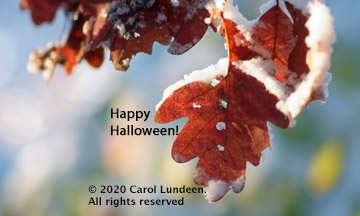Tag Archives: Native
TOUGH NATIVE PLANTS FOR ROUGH SEASIDE CONDITIONS – ROCKPORT, MA
Want beautiful, tough plants in your garden?
Carol visited Rockport, MA recently and shows us two tough-as-nails native plants for your garden that also provide habitat for wildlife.
Powerful pollinator magnets – design with native perennials for fall bloom
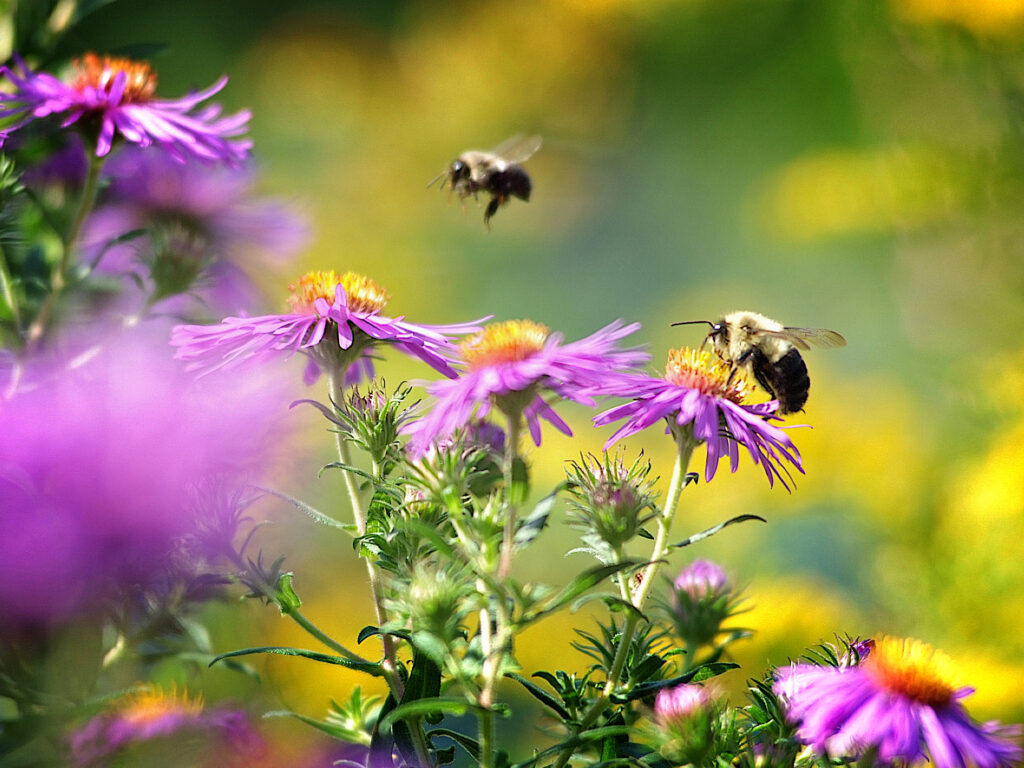
Native asters and goldenrod attract native bees at Foxborough Conservation Commission’s Lane Learning Center
Plant Goldenrods and Asters to Support Pollinators in Late Summer
According to the National Wildlife Federation, native asters like New England (Aster novae-angliae), New York (Symphyotrichum novi-belgii), smooth (Aster laevis), white wood (Aster divaricatus) and other woodland asters support the entire life cycles of over 110 species of butterflies and moths, so it you want a pollinator garden, these are must-haves. And the good news is that it’s ragweed rather then goldenrod that causes so many allergies in late summer, so plant away!
Goldenrods such as zig-zag (Solidago flexicaulis), showy (Solidago speciosa), seaside (Solidago sempervirens), and anise-scented (Solidago odora) species are the top champions of supporting the entire life cycles of butterflies and moths in New England, supporting 110 species in eastern MA.
More good news is that there are asters and goldenrods that do well in shady and dry conditions, so don’t worry if you’ve not much sun – so get out there and help pollinators by planting the plants they depend upon for their very existence.
What plants are best for native bees?
Obviously they like goldenrods and asters as pictured above, but even better are native roses, like Carolina (Rosa caroliniana), Virginia (Rosa virginiana), swamp rose (Rosa palustris) and shining (Rosa nitida), plus flowering raspberry (Rubus odorous). As always, before purchasing plants, know your site’s cultural conditions – like sun/shade, soil texture and drainage – and select the best species for your conditions so your investment has the best chance of thriving.
Birds and other animals will thank you for providing habit – like food, shelter and nesting sites – that looks so satisfying to you!
FULFILL THE DREAM OF CREATING A POLLINATOR GARDEN
WHY NOT TURN YOU LAWN INTO A CERTIFIED HABITAT GARDEN FOR BUTTERFLIES, BEES, BIRDS?
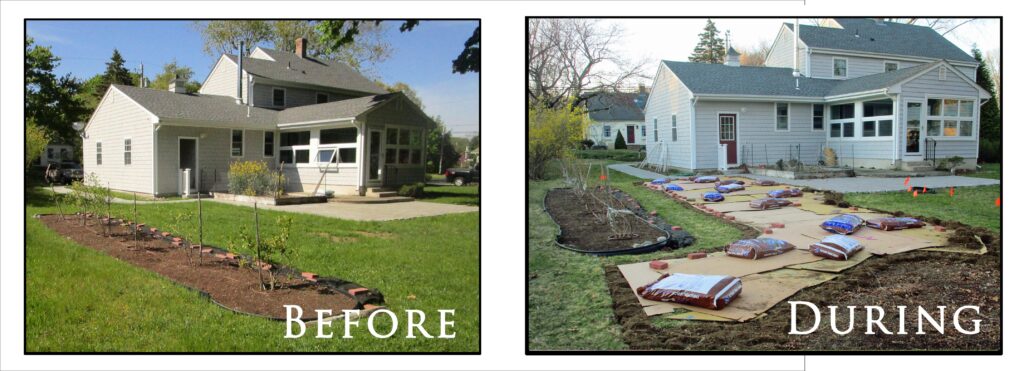 We’re helping a homeowner in Seekonk, MA fulfill her dream of turning most of her lawn into pollinator habitat. Collaborating through the iterative design, installation, and maintenance phases, the client herself has gotten earth under her fingernails and dirtied the knees of her jeans every step of the way.
We’re helping a homeowner in Seekonk, MA fulfill her dream of turning most of her lawn into pollinator habitat. Collaborating through the iterative design, installation, and maintenance phases, the client herself has gotten earth under her fingernails and dirtied the knees of her jeans every step of the way.
In the 2020 season we designed and installed two crescent-shaped ornamental landscape beds for MA native trees, shrubs and perennials. In the spring of 2021 we’re expanding upon last year’s work by tying in a larger portion of the back yard lawn. Because we have time on our side before the arrival of native plant meadow kits from the Native Plant Trust, we’re using the sheet composting aka lasagna method of turning lawn into garden beds.
Using flags and garden hoses, we laid out the shape of the new planting area, tweaked it, then committed to it by laying down two layers of heavy cardboard that came from local bicycle and appliance stores. The cardboard keeps sunlight from the grass to keep it from growing.
On top of the cardboard we’ll be laying down high quality drip irrigation hoses, aka pipes, that will tie into the existing lawn irrigation system. The pop-up sprinkler heads of the zone where this section of pollinator bed is going were removed and capped to preserve water, water pressure, and associated financial costs. Continue reading
GOT SPRING FEVER? HELP POLLINATORS THIS YEAR!
Pollinate New England Program in Wellesley Shows You How to Plan and Plant a Pollinator Garden
The Wellesley Natural Resources Commission hosted a live Pollinate New England program (pre-Covid) on the importance of using native plants to support New England’s bees, insects and other pollinators. Watch this video of the program to learn the actual steps of creating a pollinator habitat garden.
Learn how to design and create a pollinator garden
You’ll learn how to attract native butterflies and moths, birds and bees to your garden and
- put the right native plants in the right places
- design the spacing of your plants to maximize their potential, have good looks and reduce weeds
- get your pollinator plants established with organic gardening practices, proper watering and care
- use ecological mulching materials and learn their benefits, such as retaining soil moisture, moderating soil temperature, and reducing weeds
The goal of Pollinate New England is to teach and encourage homeowners to plant diverse, systemic pesticide-free native plants that support a wide variety of pollinators throughout their life cycles. It’s an initiate of the Native Plant Trust (formerly New England Wild Flower Society), which received an IMLS grant to create a network of pollinator gardens, collaborating with twelve partners throughout six states, supported by a suite of in-person and distance programs and resources.
Sharpen the Saw at the 27th Ecological Landscape Alliance Conference & Eco-Marketplace: March 3-4
What to do for your habitat and pollinator gardens this winter? It’s learning season!
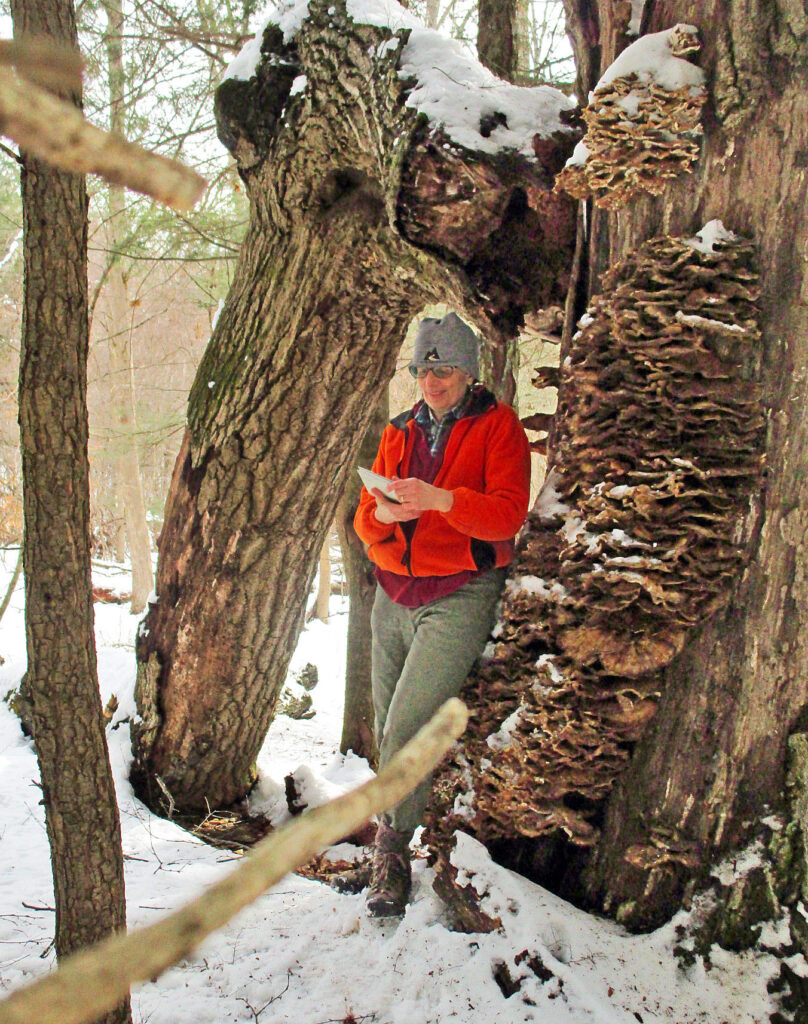
Garden-911 Boston owner Carol Lundeen learns to estimate the age of an old growth northern red oak tree. Since the actual age of trees cannot be determined without cutting the trunk and counting its individual growth rings – or by using a core boring tool – she instead used her outstretched arms as a measuring tape to estimate its circumference, which was more than three times her reach. Dividing the circumference by pi (approx 3.14), she arrived at the DBH (diameter at breast height). Using an arborist multiplication factor specific to northern red oaks, she estimated that this Quercus rubra lived for about 265 years old before its growth potential, environmental and cultural factors brought on its demise – though it’s now continuing the cycle of life by being home to walls of fungi, birds, insects and other wildlife.
Nothing like having something inspiring to look forward to during a pandemic – like learning! The Ecological Landscape Alliance’s 27th Conference and Eco-Marketplace lights up my calendar on March 3-4 and I can’t wait to sample the design, climate change/resilience and inclusion tracks. Below are the top ten talks I’ve circled so far. For more info, visit https://www.ecolandscaping.org – I hope to see you there!
Learn about top new trends in native plant and pollinator gardens, design and consulting:
- Toby Wolf, Wolf Landscape Architecture: “Sharing the Adventure: Design Communications for Ecological Landscapes”
- Gerdo Aquino, SWA Group: “The Aesthetics of Ecology and Why Design Matters”
- Nadia Malarkey, Nadia Malarkey Design: “Regenerating Suburbia One Garden at a Time”
- Lisa Hayden, New England Forestry Foundation: “Engaging Landowners in Sustainable Stewardship”
- Leah Penniman, Soul Fire FarmFarming While Black: “African ” Wisdom for Farming and Food Justice”
- Ryan Serrano, Earth Steward Ecology Inc: “Regenerative Landscape Essentials: Tethering Function and Aesthetic
- Pamela Conrad, CMG Landscape ArchitectureClimate Positive Design – Going Beyond Neutral
- Dan Jaffe Wilder, Norcross Wildlife Sanctuary: “Taking on the Big Places: How to Build and Maintain Self-Sufficient Landscapes”
- Thursday’s Luncheon Discussion: “Diversity, Equity, and Inclusion in Horticulture”
- Anna Fialkoff, Wild Seed Project: “Rewild in 10 Action Steps
About the ELA (Ecological Landscape Alliance)
Here’s the scoop on the ELA, of which I’m a member, quoted from the ELA website:
“Since its founding in 1992, the Ecological Landscape Alliance has been a leader in promoting sustainable approaches to landscape design, construction, and management. ELA’s commitment to innovative ideas and evidence-based practices has made the organization both a trusted resource and a vibrant community of landscape professionals and devoted gardeners.
Our Mission
The Ecological Landscape Alliance advocates for ecological landscape practices through education, collaboration, and outreach.
Our Vision
Everyone who interacts with the land is a steward whose actions are informed by an understanding of and respect for natural systems.”
For more info visit https://www.ecolandscaping.org
Happy Halloween from Your Local White Oak Tree
THE WONDER OF PLANT ADAPTATIONS at NATIVE PLANT TRUST
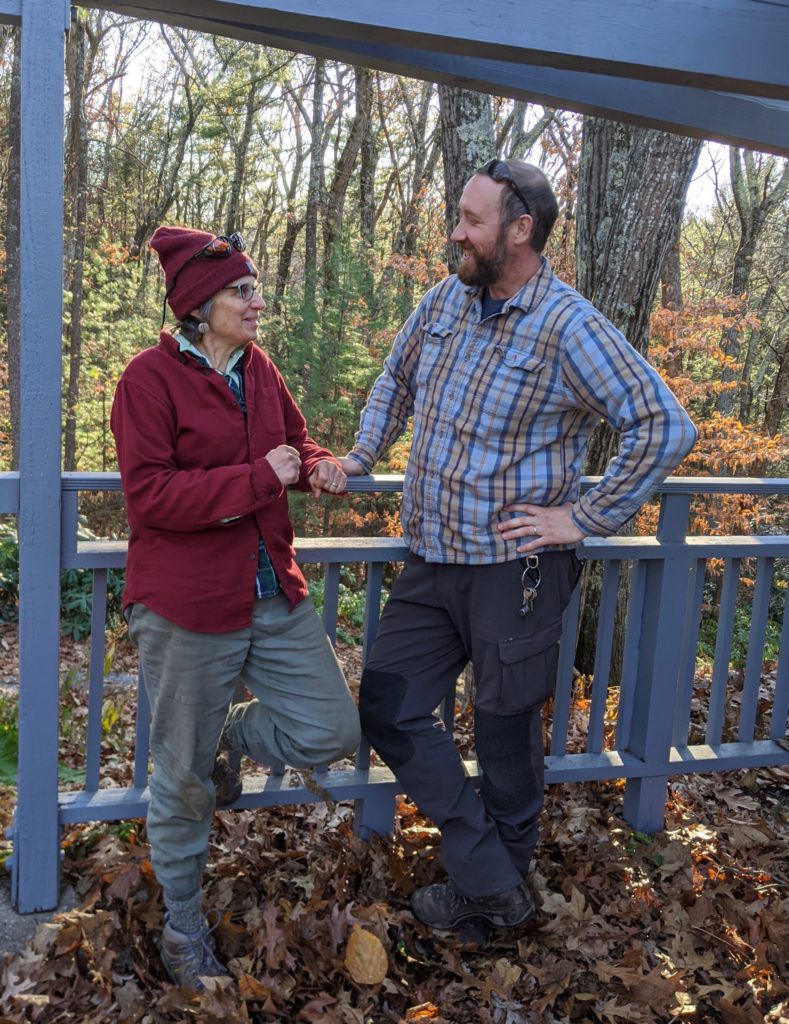
Carol Lundeen with Native Plant Trust Director of Horticulture Uli Lorimer outside the Trust’s education building after his Plant Adaptations class at the Trust in Framingham, MA. Lorimer demonstrated how every feature of a plant is a result of an adaptation designed to afford reproductive, environmental or cultural success.
The magic of botany. If you love botany, or appreciate nature, you would have loved Uli Lorimer’s Plant Adaptations class at Native Plant Trust. Right down to the molecular level, every feature of a plant is a result of an adaptation designed to afford reproductive, environmental or cultural success. This class explored the myriad ways plants have adapted to different habitats, soil types, pollination and dispersal schemes while co-evolving with other organisms in shared, co-dependent ecosystems.
Some adaptations may make it very difficult for a plant to survive in different environments, cultural and/or ecological conditions than those in which it evolved over time, which is why climate change makes it so difficult for some plants that their populations and distributions have declined, and some are vulnerable to extinction. Other plants are able to thrive and reproduce in a wide variety of situations, and so can overcome and replace vulnerable populations.
Native Plant Trust’s mission is to conserve and promote New England’s native plants to ensure healthy, biologically diverse landscapes, and vision is that through their leadership, New England’s native plants will exist in vigorous populations within healthy, evolving ecosystems, and people across the region will actively promote and protect them in the wild and in their gardens.
As Director of Horticulture at Native Plant Trust, Lorimer oversees Garden in the Woods, a botanic garden in Framingham, MA, and Nasami Farm in western MA, a nursery focused on propagation of and research about New England native plants.
SAVE THE DATE: 9/26 A FIELD DAY FOR MONARCHS!
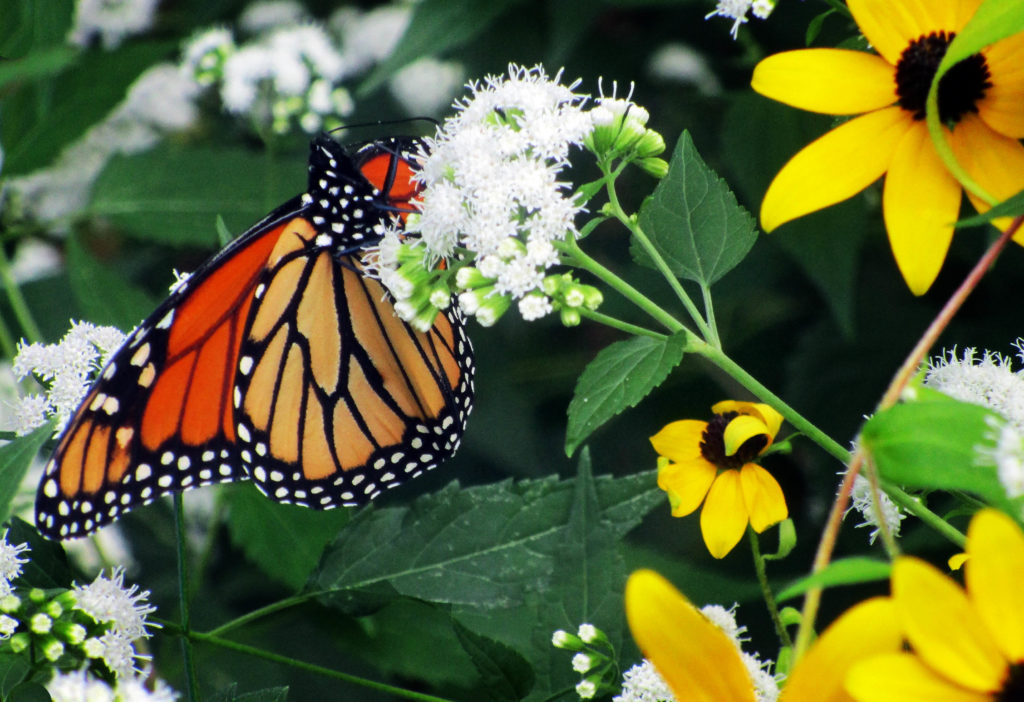 A monarch butterfly, Danaus plexippus, feeds on the nectar of white snakeroot flowers, Ageratina altissima, during its southern migration in a Sharon, MA garden on September 26, 2019. This pair of natives co-evolved since the retreat of the last ice age, and they depend on one another, and the entire web of life, for their continued existence.
A monarch butterfly, Danaus plexippus, feeds on the nectar of white snakeroot flowers, Ageratina altissima, during its southern migration in a Sharon, MA garden on September 26, 2019. This pair of natives co-evolved since the retreat of the last ice age, and they depend on one another, and the entire web of life, for their continued existence.
MONARCHS DELIGHT
September 26th was like a dream to me. I looked out the kitchen window while doing the dishes, and there were several monarchs in my gardens, all at one time. I’d seen one or two here and there this season, but never a parade of several at a time, like that day. I dropped the dishes and dashed out with my camera.
Later, on arriving at a Sharon, MA client’s gardens, Monarchs flew up every time I turned a corner on the mowed paths that snake around many beds where clouds of white snakeroot are now in bloom. I counted at least two dozen monarchs at least twice, and twice saw four monarchs on one snakeroot. It was like living and working in a dream where the monarchs have recovered and are robust in numbers again. It wasn’t a dream, but it was a remarkable parade of flight and feed that I shall not forget. Of course there were other native butterflies, like spangled frittilaries, and native bees, like Bombus sp., and other native plants in bloom.
THE BEST PLANTS FOR POLLINATORS: We can all make a difference in our yards, our gardens, our landscapes, our containers, one plant at a time, by design. Please join me doing so! These are the native plants that support the entire life cycle of the most butterfly and moth species:
Trees and shrubs:
- Oak trees – Quercus sp. such as white, red, pin, black, bear
- Willow trees – Salix sp.
- Black cherry trees – Prunus serotina
Herbaceous plants:
- Goldenrods – Solidago sp. such as blue-stem (axillary), seaside, bog, white, showy, downy, zigzag
- Asters – Symphyotrichum, Oclemena, and Aster sp. like New England, tartarian, heart-leaved, large-leaved, purple-stem, bushy, small white
- Milkweeds – Asclepias sp. like common, butterfly weed, swamp, poke, butterfly, clasping, green
Have fun, and let me know if you need a hand!
GARDEN REVOLUTION TALK IN SHARON
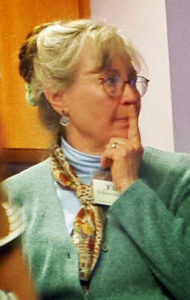
Beautiful historic gardens inspired us in the past. What inspires us to-day? And what does it mean for our backyards and our sense of self? Gardening teaches us to notice, to be patient, but the biggest lessons come when we embrace a new reason to care about what we plant and how we maintain our gardens. Ellen Schoenfeld-Beeks explains at her “Why We Need a Garden Revolution” talk at the Unitarian Church of Sharon on May 3rd. Ellen maintains an extensive mostly-native plant garden at her Sharon home, and also oversees the plantings and Memorial Garden at the church.
If you care about your chickadees, what does this range of numbers mean: 350 to 570? My environmental and social justice pal Ellen Schoenfeld-Beeks let us know at her “Why We Need a Garden Revolution” talk at the Unitarian Church of Sharon, MA on May 3rd. The answer is, 350 to 570 is the number of caterpillars one pair of chickadees needs every day to nurture their chicks from hatching to fledging. That’s just one pair of one kind of bird! Ellen inspired us to think and be mindful about every plant and practice in our gardens, and whether and how each helps or harms the natural systems that support all living things.
Ellen, who manages the church’s extensive gardens, showed examples of native plants at the church’s gardens and at her own home through the seasons, and how they support or harm our native pollinators, wildlife and local ecosystem at large. She even talked about plants she introduced to her gardens on purpose, only to find out years later that they were actually exotic invasive look-alikes of native plants. For example, she thought she was planting yellow marsh marigolds (Caltha palustris), but they turned out to be fig buttercups (Ranunculus ficaria, or, Ficaria verna), which are on the MA list of plants that are prohibited from sale.
After about three years they had spread like a spring carpet of yellow, in part because they aggressively reproduce by three different mechanisms. Once she realized her error, Ellen took responsibility and removed them by hand, an intensive but organic gardening practice. It took three seasons to bring their numbers to a reasonably manageable level.
Ellen also reminded us that one of the Unitarian Universalist Church’s guiding principles is respect for the interdependent web of all existence of which we are a part. She urged us to think carefully and learn about the impact of each of our plantings, as every plant in our landscapes matters, and your landscape supports, or doesn’t, those chickadees who need all those caterpillars every day to raise their young.
The design of her home garden, also in Sharon, features primarily native plants with mowed and gravel paths that sweep around her layered ornamental planting beds and stone walls, leaving the visitor wondering with curiosity what lies just past the next curve. Each of her beds have themed names, such as Mountain Laurel Hill, the Meadow and Old Rose Garden. Some of her favorite native plants are mountain laurel, Kalmia latifolia – obviously – with an area named just for them; apothecary rose, Rosa gallica, which though not a native has been cultivated by people since the MIddle Ages; and various goldenrods, which support at least 115 species of butterflies and moths.

